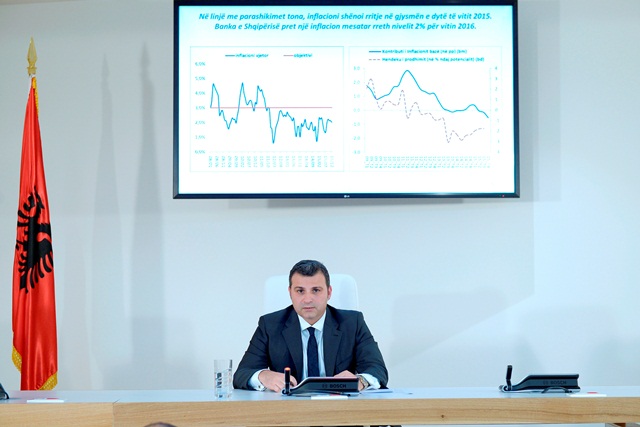BANK OF ALBANIA
PRESS RELEASE
Governor Sejko: Statement to the Press Conference on the Monetary Policy Decision of the Supervisory Council, 3 February 2016
Publication date: 03.02.2016
The Supervisory Council met today in the second meeting in 2016 and reviewed and decided on the interest rate. Let me now explain our assessment and conclusions in greater detail.
***
New data for the third and fourth quarters of 2015 show that economic activity in Albania is moving along a positive trajectory. Our analyses and forecasts suggest that the Albanian economy will continue to see positive growth rates in the next three years. Economic activity is expected to return to equilibrium in the first quarter of 2017 and inflation is expected to return to target in the second quarter of 2018

These forecasts have not changed our previous assessments. The direction and intensity of expected developments reflects: (i) actual dynamics of the Albanian economy; ii) expected improvement of the external environment; and (iii) maintaining the accommodative monetary policy stance over the forecast horizon. Let me now briefly explain these factors.
During the second half of 2015, the economy performed on the up side of our expectations. As a result, the expected economic growth for the year was revised slightly up. Based on the current trends, the Bank of Albania expects economic growth to accelerate somewhat in 2016. In the meantime, inflation is expected to average around 2% in this period.
According to INSTAT data, the Albanian economy posted 2.98% growth in the third quarter, driven mainly by the increase in investments and recovery of the activity in the services sector. Indirect data for the fourth quarter suggest that growth remained in positive territory.
Analysing the available information, the Bank of Albania deems that private investments will continue to grow, fuelled by foreign direct investments, improvement of firms' financial situation, due to payment of arrears, and easing of financing conditions by the banking sector.
Also, household consumption has seen growth whereas its determining factors - employment, wages and consumer confidence - showed improvement. On the other hand, Albanian exports are suffering from the sluggish performance in Albania's trading partners and unfavourable conjuncture in international markets. In addition, public spending fell during 2015, reflecting the strong fiscal consolidation by the public sector.
Inflation rose slightly during the fourth quarter, averaging 2.1%. Inflation went through a progressive rising trend in the second half of the year, reflecting in part the improvement of economic activity and the transitional effects of the low comparative base against the previous year. However, in line with our previous statements, inflation remains below Bank of Albania's target. This performance illustrates the fact that employment and the capacity utilisation rate remain below their potential. It also highlights the need for stimulating economic policies in the medium term.
The unfavourable situation in Albania's trading partners and international markets has not contributed to the economic activity in Albania in the second half of 2015. Developments in Greece, low oil and commodity prices, and frequent fluctuations in the financial markets have led to low demand for Albanian exports and did not encourage credit growth. This situation is expected to slightly improve over 2016. While monitoring actual economic trends and international institutions' projections, the Bank of Albania judges that the external environment is expected to strengthen in the medium-term horizon, and increasingly support economic growth in Albania.
Moreover, economic growth over this period is expected to be driven by the improvement of financing conditions and credit recovery. This expectation reflects a combination of a series of underlying factors.
First, the strong accommodative monetary policy stance has brought interest rates in financial markets to historic minimum levels. The Bank of Albania deems that these rates will remain below the historic average over the next two years.
Second, the issue of the euro bond led to the reduction of public borrowing in domestic financial markets. This has subsequently brought interest rates further down - even beyond signals given by the monetary policy - thus contributing to the increase of the monetary policy stimulus in the economy In accordance with the medium-term budget plan, the Bank of Albania deems that the effect of this factor will be also present over the next two years.
Third, the implementation of the plan of actions for reducing non-performing loans will contribute to the easing of credit standards and the increase in bank credit supply.
In view of the above arguments, economic growth will further improve in the medium-term horizon, fed initially by the domestic demand and later by the steady growth of exports. This growth will help in the gradual return of inflation to the 3% target.
Bank of Albania's analysis suggests that the actual monetary conditions are adequate for achieving the inflation target within a medium-term horizon. Based on this judgement, the Supervisory Council decided to keep the key interest rate unchanged at 1.75%.
Following, in the light of achieving our inflation target and economic growth approaching its potential, based on the available information, the Bank of Albania judges that the intensity of the monetary stimulus will not weaken throughout 2016 and our monetary conditions will remain accommodative in the next two years.
Lastly, I would like to reiterate the need for the continuation and acceleration of structural reforms. These reforms are the only instruments to place the economy on a faster growth track as well as a principal tool to bolster Albania's economic and financial stability.

 Twitter
Twitter
 Youtube
Youtube
 Facebook
Facebook
 Flickr
Flickr
 RSS
RSS
 Subscribe
Subscribe
 Feedback
Feedback